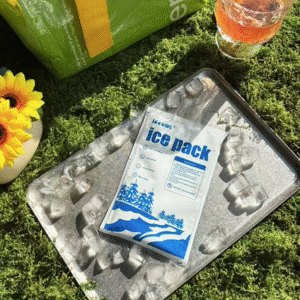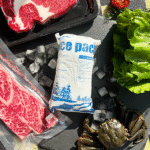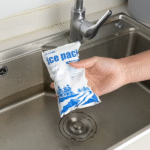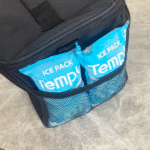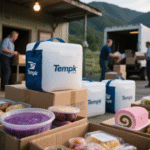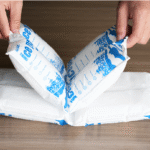Trockeneis-Pellets oder Trockeneis-Pack: Which Should You Use?
If you ship frozen food, Biologika, oder Laborproben, dry ice pellets Und Trockeneisbeutel formats are your fastest path to stable sub‑zero control. You’ll learn how to size them, pack them, und folgen 2025 rules without guesswork. Expect practical math, real SOPs, and tools you can roll out this week.
-
Select dry ice pellets oder Trockeneisbeutel by lane risk and target range
-
Size charge weight for 24–72 hours using simple, repeatable math
-
Build a five‑layer packout SOP that cuts melt claims in hot seasons
-
Berechnen cost per cold hour and spot break‑even vs gel and PCM
-
Apply UN1845 marks, Netzmasse, and ventilation requirements correctly
-
Schiene 2025 Trends, from lighter insulation to hybrid packouts
How many dry ice pellets or dry ice pack do you need?
Kurze Antwort: start at 1–1.5 lb per quart of payload volume for 24 Std., Dann hinzufügen 40–60% per extra day. Use the higher end for hot lanes or frequent opens. Dry ice pellets chill fastest; Trockeneisbeutel distributes cold more evenly with less handling time.
That baseline works because heat leaks through lids and walls at predictable rates. If your product must stay ≤0°F, beide dry ice pellets Und Trockeneisbeutel beat gel bricks by wide margins. In shoulder seasons or tight urban routes, you can trim 10–15% if you pre‑chill the cavity and minimize empty headspace.
Dry ice pellets vs block vs slab: was länger hält?
Dry ice pellets offer quick pull‑down and flexible placement. Trockeneisbeutel delivers stable coverage and easier SOPs. Blocks/slabs last longest per pound but are harder to fit around mixed SKUs.
| Format | What It Excels At | Typical Sublimation | What It Means for You |
|---|---|---|---|
| Dry ice pellets | Rapid cool‑down, small voids | Schnell (high surface area) | Great for pre‑chill and tight corners |
| Trockeneisbeutel | Even coverage, fast training | Mäßig | Consistent hold time across cartons |
| Block/slab | Longest runs, minimal access | Slowest | Strong longevity, trickier placement |
Praktische Tipps und Ratschläge
-
Summer lane ≥90°F: fügen Sie a hinzu top layer regardless of format; it blocks radiant heat from lids.
-
Häufige Tür öffnet sich: budget +25–35% over baseline; warm air swaps are the silent killer.
-
Reusable coolers: A Trockeneisbeutel top sheet protects labels and reduces fogging.
Tatsächlicher Fall: A pastry brand added a top layer of Trockeneisbeutel above cupcakes for a 36‑hour desert route. Replacements fell by two‑thirds while packout time stayed under five minutes.
How to use dry ice pellets dry ice pack safely?
Fazit: lüften, insulate skin contact, und deutlich beschriften. Dry ice pellets Und Trockeneisbeutel release CO₂ gas as they warm. It is heavier than air and can displace oxygen in still rooms. Always open shippers in ventilated areas and wear insulated gloves rated for low temperatures.
Treat CO₂ like invisible water that pools low. Keep openings away from floor wells, install a CO₂ monitor near pack benches, and spread out unboxing times. A one‑page SOP plus a two‑minute huddle before peak shifts keeps teams sharp and safe.
CO₂ ventilation checklist for dry ice pack areas
Set the space, sense the air, and stage the flow. Small changes make a big safety difference with dry ice pellets Und Trockeneisbeutel Handhabung.
| Control | What to Do | Warum funktioniert es | For You |
|---|---|---|---|
| Belüftung | Fan or local exhaust near benches | Disperses CO₂ quickly | Sicherer, faster receiving |
| PS | Cryo‑safe gloves, long sleeves | Prevents frost contact | Fewer minor injuries |
| Sensors | CO₂ monitor at breathing height | Early warning | Audit‑ready safety logs |
| Staging | Unbox in batches, not piles | Limits CO₂ spikes | Glatt, calm workflow |
Praktische Tipps und Ratschläge
-
Small rooms: crack a door and point a box fan outward during busy windows.
-
Night shift: place CO₂ meter alarms where noise is easy to notice.
-
New hires: demonstrate pellet behavior outside; seeing “fog” movement teaches fast.
Beispiel aus der Praxis: A hospital lab moved its bench near a roll‑up door and added a low‑set CO₂ sensor. Alarms dropped to zero through summer receiving.
Packout SOP with dry ice pellets and dry ice pack
Use a five‑layer method: pre‑chill → bottom → sides → product → top. Dry ice pellets pre‑chill the cavity fast. A Trockeneisbeutel top layer creates a cold “ceiling” that slows heat entering from the lid.
Pre‑chill the empty cooler for 15–30 minutes. Line sidewalls to stop leaks, and center your payload with light void fill. For fragile items, add a thin corrugate buffer between cold media and goods to prevent freeze spots.
Five‑layer method details (dry ice pellets + Trockeneisbeutel)
Make each layer do a job. The top layer is non‑negotiable; most heat comes from above.
| Schicht | What It Is | Was zu verwenden | Warum es hilft |
|---|---|---|---|
| Vorschreibe | Quick cooldown of cavity | A scoop of dry ice pellets | Cuts early sublimation losses |
| Unten | Cold floor | Flat Trockeneisbeutel | Blocks conductive heat |
| Seiten | Cold sleeves | Half Trockeneisbeutel or liner | Stops sidewall losses |
| Produkt | Payload centered | Trays or cartons | Reduces cold spots |
| Spitze | Cold lid | Full Trockeneisbeutel | Stops radiant and convective heat |
Praktische Tipps und Ratschläge
-
Glass vials: buffer with a 2–3 mm corrugate sheet under top Trockeneisbeutel.
-
Meeresfrüchte: verwenden dry ice pellets in corners to fill odd gaps around bags.
-
Mahlzeiten: tape two Trockeneisbeutel sheets together to keep a flat cold ceiling.
Tatsächlicher Fall: A DTC ice‑cream brand switched to this SOP with dry ice pellets in corners and a Trockeneisbeutel Deckel. Summer melt claims dropped 58% without changing courier.
Cost math: dry ice pellets vs dry ice pack vs gel/PCM
Ziel: minimize cost per cold hour while hitting your target temperature. Dry ice pellets are superb at fast pull‑down. Trockeneisbeutel distributes cold with fewer SKUs and simpler training. Gels and PCMs fit when your target is above freezing and lanes are predictable.
Think in ratios, not perfection. Measure “cold hours” in a pilot, divide your material cost by those hours, and compare across options. Wann dry ice pellets oder Trockeneisbeutel allow a smaller outer carton, dimensional weight savings often tip the scales.
Quick break‑even calculator
Example numbers you can adapt
-
Hot two‑day lane, small EPS: pellets cool fast but sublimate quicker; packs win on total charge.
-
Short urban lanes, frequent opens: pellets shine due to rapid recovery on door swings.
-
Hybrid PCM + Trockeneis: above‑freezing targets do better with PCM sidewalls and a thin Trockeneisbeutel lid for spikes.
| Vergleich | Trockeneispellets | Trockeneisbeutel | Ihr Mitnehmen |
|---|---|---|---|
| Pull‑down speed | Fastest | Schnell | Pellets recover temp after door opens |
| Longevity/lb | Untere | Höher | Packs reduce charge weight on long hauls |
| Labor/time | Scoop and fill | Sheet and tape | Packs train faster for seasonal staff |
| Box utilization | Fills odd voids | Flat planes | Packs protect labels and paperwork |
Actual example: A meal subscription brand replaced 4 gel bricks with one Trockeneisbeutel top and a thin PCM sidewall. Material SKUs fell 40%, and per‑box cost dropped 9–12% depending on zone.
Einhaltung: labels and rules for dry ice pack shipments in 2025
Treat it as “Carbon dioxide, solide" (UN1845). Most air services require the proper shipping name, Die net mass of dry ice, and package venting. Ground rules are simpler but still ask for clear marks. Dry ice pellets Und Trockeneisbeutel follow the same description; only the form factor differs.
Print the UN number and net mass on the box, place the label on the side, and keep vents clear. If you use a liner bag, perforate the top so gas can escape while the shipper stays sealed. For regulated health goods, update your quality records when you change the Trockeneisbeutel count or pellet weight.
Labeling checklist for dry ice pellets and dry ice pack
| Erfordernis | What to Print | Warum | For You |
|---|---|---|---|
| Eigenname | Kohlendioxid, solid — UN1845 | Universal ID | Schnellere Akzeptanz |
| Netzmasse | „Trockeneis: X kg” | Sicherheit & Handhabung | Accurate handling limits |
| Lüftungsschlitze | Small holes or gaps | Gas escape | Prevents bulging or panel pop |
| Orientation | Up arrows if needed | Correct handling | Fewer damages or returns |
Praktische Tipps und Ratschläge
-
Mixed contents: add net mass to the packing list for audit trails.
-
Returns: include a “do not reseal” note to avoid trapping CO₂.
-
Barcode labels: keep a 2–3 mm insulating square under label zones near a Trockeneisbeutel Deckel.
Tatsächlicher Fall: A biotech added net mass to outbound labels across SKUs. Courier exceptions dropped, and pickup reliability improved within two weeks.
Pellet sizes, pack styles, and where each wins
Not all dry ice pellets are alike. Small pellets (≈3 mm) pour into tight voids and cool fast. Large pellets (≈10–16 mm) länger dauern. Trockeneisbeutel styles include flat sheets, pillows, and scored “book” packs that fold into side sleeves.
Choosing pellet size and pack style
| Option | Size/Style | Am besten für | What It Means for You |
|---|---|---|---|
| Micro dry ice pellets | ~3 mm | Tight cavities, fast pulls | Great pre‑chill; faster sublimation |
| Standard dry ice pellets | 10–12 mm | Balanced cooling & Handhabung | Good all‑round choice |
| Maxi dry ice pellets | 16 mm | Long runs, fewer opens | Longer hold per scoop |
| Flat Trockeneisbeutel | Blatt | Top/Bottom layers | Smooth lid; schützt Etiketten |
| Pillow Trockeneisbeutel | Pillow cells | Cushion + kalt | Gentle around fragile items |
| Scored “book” pack | Faltbar | Sidewalls and corners | Einfach, repeatable SOPs |
Praktische Tipps und Ratschläge
-
Odd‑shaped seafood boxes: blend large pellets with a small scoop of micro pellets to seal gaps.
-
Long lanes with no opens: choose maxi pellets or a thicker Trockeneisbeutel Spitze.
-
Training new staff: start with flat Trockeneisbeutel; it is hard to misplace.
Actual example: A vaccine distributor replaced pellets with scored Trockeneisbeutel side sleeves. Pack time fell 22% and hold time improved, thanks to fewer gaps.
2025 trends using dry ice pellets dry ice pack
Three shifts stand out in 2025: lighter insulation with equal R‑value, container‑level sensors that log temperature and CO₂, and hybrid packouts that pair Trockeneisbeutel lids with PCM sidewalls. These changes reduce charge weight while improving consistency.
Neueste Entwicklungen auf einen Blick
-
Lightweight vacuum panels: same thermal performance, smaller boxes, less Trockeneisbeutel Masse.
-
Temperatur + CO₂ data loggers: protect staff and product; alarms cue ventilation at docks.
-
Hybrid-Packouts: dry ice pellets for rapid pull‑down, Trockeneisbeutel for steady hold.
Market insight: DTC frozen foods and specialty health shipments continue to grow. Lanes are more variable, especially last‑mile heat spikes. Teams, die standardisieren Trockeneisbeutel for lids and deploy dry ice pellets for pre‑chill see fewer exceptions and simpler SOPs across seasons.
FAQs: dry ice pellets dry ice pack
How long do dry ice pellets last vs a dry ice pack in a mid‑grade cooler?
Pellets cool faster but sublimate quicker; expect 24–36 hours. A Trockeneisbeutel lid typically goes 30–48 hours when the box stays closed.
Can I place a dry ice pack directly on food?
Use a thin cardboard or foam sheet to buffer texture‑sensitive items. You’ll keep cold while avoiding freeze damage.
How many pounds of dry ice pellets for 24 Std.?
Start with 1–1.5 lb per quart of payload area. Add 40–60% per extra day or for hot routes and frequent door opens.
Are dry ice pellets allowed on planes?
Ja, with UN1845 labeling, declared net mass, und Belüftung. The format (pellets vs pack) does not change the basic requirement.
Do dry ice pellets damage labels more than a dry ice pack?
They can if piled under label zones. Verwenden Sie a Trockeneisbeutel lid and insulate the label area with a thin corrugate square.
What gloves are best when handling a dry ice pack?
Licht, insulated gloves rated for cryogenic contact. They protect skin while keeping dexterity for taping and small parts.
User tools: two‑minute selector and mini‑audit
Two‑Minute Selector
-
Zieltemperatur?
-
≤0°F → prefer Trockeneisbeutel Spitze + pellets for pre‑chill
-
2–8°C → PCM sidewalls; minimal Trockeneisbeutel only for spikes
-
-
Lane exposure?
-
Hot or delay‑prone → add 25–40% Trockeneisbeutel mass on top
-
-
Access frequency?
-
Frequent opens → use dry ice pellets at corners for quick recovery
-
-
Box size?
-
Tight fit → switch to flat Trockeneisbeutel and scored side sleeves
-
Mini‑Audit Script (copy/paste into SOP)
2025 sustainability and supply for dry ice pellets
Good news: many suppliers source CO₂ from existing industrial streams, not new emissions. Right‑sizing packouts and improving insulation reduce total pounds of dry ice pellets oder Trockeneisbeutel per order. Reusable containers with gasketed lids extend hold time so you need less media.
Better practice: folgen measure → reduce → offset. Measure your average pounds per shipment. Reduce with smaller boxes, lid insulation, and smarter lane planning. Offset residuals if required by corporate policy, and report the gains quarterly.
Praktische Tipps und Ratschläge
-
Reusable loops: aim for ≥10 turns; Trockeneisbeutel pairs well with rigid totes.
-
Lid boosters: a 1‑inch foam board under the Trockeneisbeutel lid often saves 10–15% mass.
-
Lane mapping: if delays happen weekly, standardize one extra top Trockeneisbeutel Schicht.
Actual example: A bakery cut dry ice pellets mass by 18% after adding a foam lid insert and switching to scored side sleeves.
Real‑world packout recipes you can copy
Frozen desserts with dry ice pack
-
Kasten: 12×10×10 inch EPS shipper
-
Medien: 2 bottom packs, 1 top pack, pellets for pre‑chill
-
Ergebnis: ≤5°F for 36 hours on a 90°F lane
Research reagents with dry ice pellets
-
Kasten: 10 L reusable hard cooler
-
Medien: Pellets pre‑chill, 1 bottom pack, 1 top pack, corrugate buffer
-
Ergebnis: ≤0°F for 24 hours with six short opens
Seafood with dry ice pellets dry ice pack hybrid
-
Kasten: 14×12×12 inch lined corrugate
-
Medien: 3 top packs, 2 bottom packs, pellets in corners
-
Ergebnis: ≤10°F for 48 hours through cross‑dock
2025‑ready training deck outline (for your team)
-
Warum dry ice pellets vs Trockeneisbeutel and when to use each
-
Five‑layer method visuals and do/don’t examples
-
Sicherheit: CO₂ behavior, glove selection, and meter locations
-
Beschriftung: UN1845, Netzmasse, Entlüftungswege, photo examples
-
Pilot testing: log template, “cold hours” calculation, change control
2025 market trends and outlook
Trendübersicht: In 2025, shippers prioritize performance at lower weight, simpler training, and sensor‑verified safety. Dry ice pellets are chosen for speed and recovery; Trockeneisbeutel is chosen for stable lids and clear SOPs. Hybrid packouts are the new normal for mixed catalogs.
Neueste Fortschritte auf einen Blick
-
Thinner, better liners: equal R‑value at 10–20% less thickness, meaning smaller cartons and less Trockeneisbeutel Masse.
-
Dual‑sensor loggers: Temperatur + CO₂ give early warnings to dock crews.
-
PCM-Hybride: PCMs handle predictable ranges; dry ice pellets and lids of Trockeneisbeutel handle spikes.
Market insight: Subscription foods, Spezialdesserts, and DTC wellness drive volume. Teams that standardize on one Trockeneisbeutel SKU and one dry ice pellets size simplify buying and reduce seasonal training time.
Common mistakes and how to fix them
-
Fehler: No top layer. Fix: Always finish with a Trockeneisbeutel lid to stop radiant heat.
-
Fehler: Labels over cold media. Fix: Insulate label zones and use flat Trockeneisbeutel beneath.
-
Fehler: Over‑packing by habit. Fix: Run a 3‑box A/B test monthly and trim 10% if hold time exceeds goals.
-
Fehler: Ignoring door‑open effects. Fix: Budget +25–35% when picks happen hourly; verwenden dry ice pellets in corners for recovery.
Häufige Fragen (extended)
Will a dry ice pack crack plastic containers?
Only with direct, prolonged contact. Use a thin buffer. Keep airflow and you’ll avoid cold‑spot brittleness.
Do dry ice pellets contaminate food?
NEIN, CO₂ sublimates cleanly. Keep pellets in mesh pouches or liners to avoid pellet scattering.
How do I dispose of a dry ice pack after delivery?
Let it fully sublimate in a ventilated area, then recycle the outer film if it’s a recyclable grade per local rules.
What’s the best pellet size for narrow vials?
Micro dry ice pellets (~3 mm) fill voids around racks. They stabilize temperature without crushing packaging.
How can I reduce fogged labels?
Verwenden Sie a Trockeneisbeutel lid to create a flat cold plane, then place a corrugate shield under the label area.
Summary and recommendations for dry ice pellets dry ice pack
Schlüsselpunkte: dry ice pellets deliver fast pull‑down and quick recovery; Trockeneisbeutel provides stable, even coverage and simpler training. Always pre‑chill, center the payload, and finish with a Trockeneisbeutel Deckel. Verwenden cost per cold hour to compare options and adjust charge weight with monthly A/B tests.
Nächste Schritte: run a three‑lane pilot with two box sizes. Record “cold hours,” net mass, and exceptions. Standardize on one Trockeneisbeutel SKU and one dry ice pellets Größe. Publish a one‑page SOP and train with a 10‑minute demo. Request a Tempk packout audit and get a lane‑specific sizing table.
Über Tempk
We help teams ship colder with fewer headaches. Our design lab tests dry ice pellets Und Trockeneisbeutel configurations for your actual lanes, then delivers a documented SOP and training kit. We focus on measurable results: weniger Ansprüche, lower spend, and faster packout time.
Aufruf zum Handeln: Book a 20‑minute consult to size your first three lanes and launch a 7‑day pilot.






